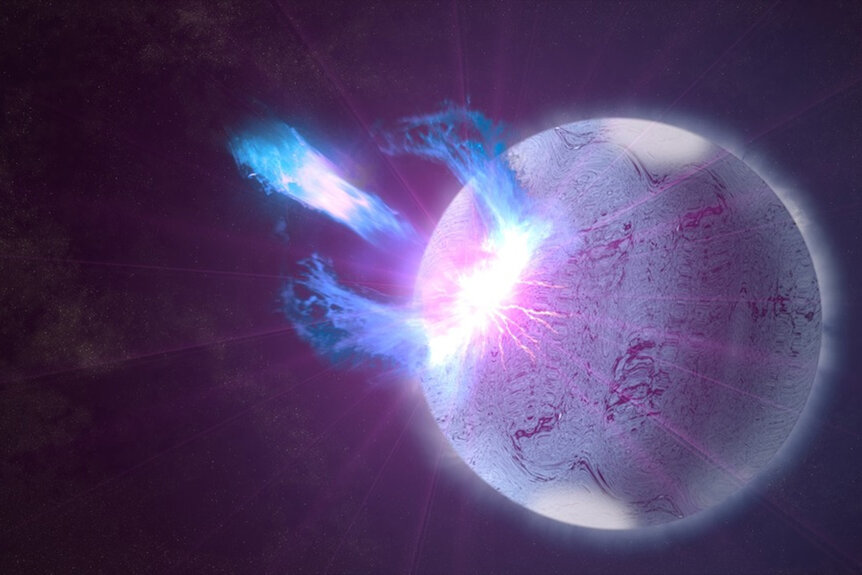Create a free profile to get unlimited access to exclusive videos, sweepstakes, and more!
Are These Strange Repeating Radio Signals Alien Communications or Something Way Weirder?
Someone, or something, is calling.

If you spend more than a few minutes looking at the night sky, you might start wondering where everyone is. With so many stars and so many worlds, it seems increasingly unlikely that we’re the only folks in town. Moreover, we’re dumping a constant stream of radio signals out into space, for anyone out there to pick up on. In fact, some scientists think those signals might already have reached an inhabited world and a response might be on the way. That we’re not all palling around with our own extraterrestrial best friends, like the lucky jerks in SYFY’s Resident Alien (streaming now on Peacock!) is, frankly, insulting.
RELATED: Scientists Say Aliens Could Contact Us As Soon As 2029
If we want to party with all of the cool extraterrestrial biological entities (EBENs) and prove once and for all if aliens exist, we might have to seek them out ourselves. And even if we don’t find them, we’ll learn a lot about the nature of the universe in the process. Win-win.
LISTENING FOR ALIEN RADIO SIGNALS
In 2007, David Narkevic, then a physics undergrad student at West Virginia University, stumbled on something unusual when combing through archival data. Two of his professors, Duncan Lorimer and Maura McLaughlin, had tasked him with sifting through 5-year-old data from the Parkes radio telescope in Australia. Narkevic was using custom software that McLaughlin and her graduate advisor had recently designed to help identify pulsars.
Manually finding pulsars can be difficult because their signals are altered as they travel through space. By the time they reach us, two similar pulsars might look totally different. As a beam of radio waves travels through space, it will encounter free electrons floating in the interstellar medium. Those electrons act like a prism, dispersing the radio wave with a preference for low frequency parts of the signal. The farther the distance from the pulse source to our telescopes, the more dispersion occurs and the longer the lag time between the arrival of the high frequency and low frequency parts of the signal. This is what’s known as Dispersion Measure, and it tells astronomers something about how far away a pulse source is. The software Narkevic was using was designed to look for a spectrum of dispersion measures so it could potentially find pulse sources from a variety of distances. That’s when he found something unexpected.
Narkevic found a strong pulse signal with a staggeringly high dispersion measure. Not only was it not in the Magellanic Cloud where his efforts were focused, it was well outside the local galactic group, at a distance of roughly 3 billion lightyears. Moreover, the amount of energy unleashed exceeded what the Sun produces in a month and was more than a billion times brighter than the brightest known pulsar. He had found something new: Fast Radio Bursts (FRBs).
FRB: ALIEN ORIGIN?
Start talking about mysterious deep space radio signals and you’re bound to get conspiracy theorists wriggling out into broad daylight. Scientific inquiry isn’t in the habit of proving negatives, so we can’t ever say definitively that it’s not aliens but… it’s not aliens. At the very least, if it is aliens, they’re playing really coy with us because FRBs are super weird, and we don’t really know what their deal is.
In the years since 2007, hundreds more FRBs have been discovered, but we’re still not sure precisely what they are or where they come from. That’s largely because they are so rare and so short-lived. So far, the vast majority of FRBs we have detected have unleashed a pulse only one time. A single magnificent explosion of energy, never to be repeated. If we’re not already looking at the right part of the sky, at the right time, we’ll miss them.
RELATED: Mysterious Radio Signal Follows Gravitational Waves Like Cosmic Thunder and Lighting
A select few, however, repeat more than once, sometimes several times. When that happens, astronomers have an opportunity to point their instruments at it and snap pictures. If you’re really lucky, your observation will coincide with a gravitational wave detection and provide some insight into the possible origin of the signal.
A BURST OF ALIEN RADIO SIGNALS
An international team of astronomers, using data from the Canadian Hydrogen Mapping Experiment (CHIME), recently discovered 25 new repeating FRBs, more than doubling the number discovered by the CHIME/FRB collaboration. There are an additional 14 candidates which, if confirmed, would bring the total up to 60.
The seeming burst of distant radio activity isn’t the result of E.T. blowing up our phones but is instead a consequence of our growing understanding of FRBs and improved observing instruments. CHIME is useful for this sort of investigation because it surveys the entirety of the northern sky every single night, increasing the likelihood that unannounced FRBs will be captured. The 25 new repeating pulse sources were all discovered from data collected between September 30, 2019, and May 1, 2021.
As detections become increasingly common and the night sky becomes more crowded with pulse sources, it will be more important to know if signals from the same apparent location are one repeating object or two distinct objects pulsing coincidentally. To that end, researchers used an unsupervised machine-learning algorithm to sift through the data, looking for pulse sources with the same apparent astronomical coordinates, defined in part by their dispersion measure.
RELATED: The weird gets weirder: A fast radio burst traced to a nearby galaxy's globular cluster
“These new tools were essential for this study because we can now accurately calculate the probability that two or more bursts coming from similar locations are not just a coincidence. It should be very useful for similar research going forward.” said Ziggy Pleunis, the first author of the paper, in a statement.
The study also revealed that there is no clear distinction in burst rate between repeating and apparently non-repeating FRBs. That is to say, you can’t tell definitively what a repeating FRB’s pulse rate will be until you see it. The study authors suggest this opens a possibility that all FRBs are, in fact, repeating FRBs. Some of them are simply less flamboyant than others.
As new telescopes and new observing techniques are built and developed, we’re likely to detect more and more FRBs, which will help us to learn more about them. Maybe someday soon, we’ll know what they are and where they come from. Maybe it’ll be aliens and maybe it won’t, but it’s sure to be exciting either way.
Get your alien bestie fix with Resident Alien, streaming now on Peacock!































